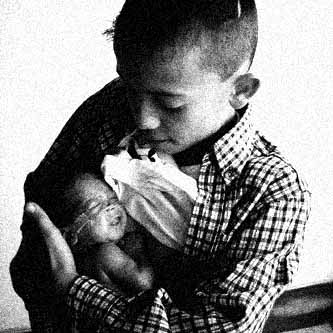The mother kangaroo method
What problem does it solve?

The seriousness of this situation, and the desire to improve the kind of attention in a more humane and scientific way, led the IMI staff to seek a fast solution. The first step was to replace formula feeding with maternal lactation. Mothers able to feed their babies and to be with their children as soon as possible were encouraged to enter the newborn care wards with the purpose of feeding them directly and forming that all important attachment. When it was not possible to nurse at the breast, babies were given milk expressed by their own mothers, or by other mothers in the hospital. The reduction of infections thanks to the antibodies present in the mother’s milk, along with the strengthening of the affectionate relationship between mother and child, were the main benefits obtained by this procedure.
The programme staff identified these efforts as the main cause of the immediate drop in gastrointestinal infections in low birthweight babies in the newborn care wards. With breast-feeding established in the newborn care wards, the programme’s central idea took hold. Other steps such as the kangaroo position (skin to skin contact) and the outpatient check-ups meant that the mother became directly responsible for the care of her small child – and had been prepared to do so.
The most important change was to provide care to premature infants not according to weight, but according to clinical conditions, trying to discharge them from the hospital as soon as possible after birth. That reduced the risk of crossed infections. The kangaroo position and a visit to the outpatient clinic immediately after hospital release complemented the development of this new method.
OBJECTIVES OF THE MOTHER KANGAROO METHOD
•Improve the prognosis and development of low-weight children
•Encourage a close relationship between child and mother as soon after birth as possible
•Humanise hospital and outpatient care of premature babies
•Teach the mother to offer her child the best possible care at home
•Make more rational use of technological resources, especially when they are limited
•Reduce the costs of hospitalisation
The Mother Kangaroo Method is an important model of cost-benefit ratio in which the premature infant survival rate, along with quality of life, is improved, and abandonment (so frequent in these cases) is avoided.
The method combines hospital, outpatient and home care, achieving better results than the more costly alternative of prolonged hospitalisation.
The mobile care at home allows for the non-use of ultrasounds and monitors; the baby will not use incubators, which avoids nosocomial infections, thus sparing the hospital the use of drugs and other hospital supplies and services.
DOWNLOAD THE BROCHURE PDF
albanian (0.9 MB)spanish (0.6 MB)
english (0.6 MB)
serbian (0.6 MB)








 COUNTRY OF ORIGIN
COUNTRY OF ORIGIN OUTSTANDING IDEASS PROJECTS
OUTSTANDING IDEASS PROJECTS